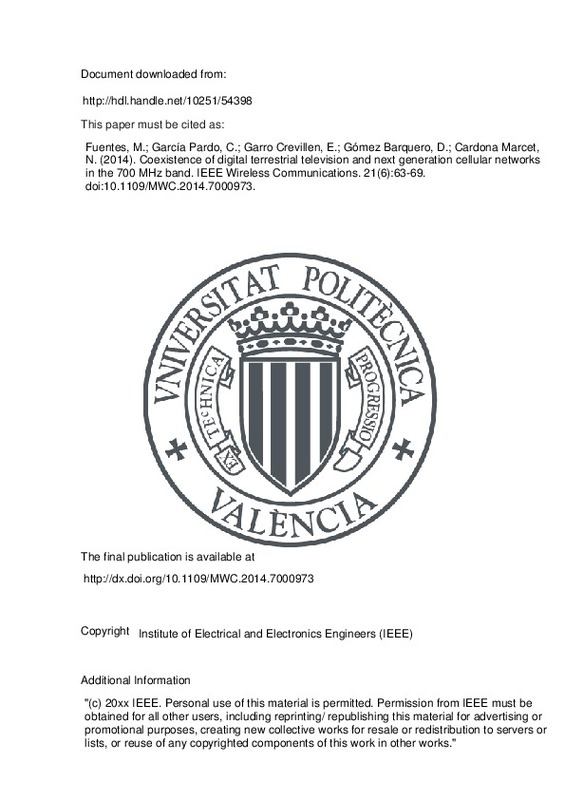JavaScript is disabled for your browser. Some features of this site may not work without it.
Buscar en RiuNet
Listar
Mi cuenta
Estadísticas
Ayuda RiuNet
Admin. UPV
Coexistence of digital terrestrial television and next generation cellular networks in the 700 MHz band
Mostrar el registro sencillo del ítem
Ficheros en el ítem
| dc.contributor.author | Fuentes, Manuel
|
es_ES |
| dc.contributor.author | García Pardo, Concepción
|
es_ES |
| dc.contributor.author | Garro Crevillén, Eduardo
|
es_ES |
| dc.contributor.author | Gómez Barquero, David
|
es_ES |
| dc.contributor.author | Cardona Marcet, Narciso
|
es_ES |
| dc.date.accessioned | 2015-09-08T11:49:44Z | |
| dc.date.available | 2015-09-08T11:49:44Z | |
| dc.date.issued | 2014-12 | |
| dc.identifier.issn | 1536-1284 | |
| dc.identifier.uri | http://hdl.handle.net/10251/54398 | |
| dc.description | "(c) 20xx IEEE. Personal use of this material is permitted. Permission from IEEE must be obtained for all other users, including reprinting/ republishing this material for advertising or promotional purposes, creating new collective works for resale or redistribution to servers or lists, or reuse of any copyrighted components of this work in other works." | es_ES |
| dc.description.abstract | With the spectrum liberation obtained by the deployment of digital terrestrial television and the analog TV switch-off, new bands are being assigned to IMT LTE. In the first cellular deployments in the digital dividend at the 800 MHz band, problems emerged due to the interference cellular networks can cause to DTT signals. Possible solutions imply either an inefficient use of the spectrum (increasing the guard band and reducing the number of DTT channels) or a high cost (using anti-LTE filters for DTT receivers). The new spectrum allocated to mobile communications is the 700 MHz band, also known as the second digital dividend. In this new IMT band, the LTE uplink is placed in the lower part of the band. Hence, the ITU-R invited several studies to be performed and reported the results to WRC-15. In this article, we analyze the coexistence problem in the 700 MHz band and evaluate the interference of LTE signals to DTT services. Several coexistence scenarios have been considered, and laboratory tests have been performed to measure interference protection ratios. | es_ES |
| dc.language | Inglés | es_ES |
| dc.publisher | Institute of Electrical and Electronics Engineers (IEEE) | es_ES |
| dc.relation.ispartof | IEEE Wireless Communications | es_ES |
| dc.rights | Reserva de todos los derechos | es_ES |
| dc.subject | Bandwidth | es_ES |
| dc.subject | Cellular networks | es_ES |
| dc.subject | Digital video broadcasting | es_ES |
| dc.subject | Interference | es_ES |
| dc.subject | Next generation networking | es_ES |
| dc.subject | Receivers | es_ES |
| dc.subject | TV | es_ES |
| dc.subject | Telecommunication traffic | es_ES |
| dc.subject.classification | TEORIA DE LA SEÑAL Y COMUNICACIONES | es_ES |
| dc.title | Coexistence of digital terrestrial television and next generation cellular networks in the 700 MHz band | es_ES |
| dc.type | Artículo | es_ES |
| dc.identifier.doi | 10.1109/MWC.2014.7000973 | |
| dc.rights.accessRights | Abierto | es_ES |
| dc.contributor.affiliation | Universitat Politècnica de València. Instituto Universitario de Telecomunicación y Aplicaciones Multimedia - Institut Universitari de Telecomunicacions i Aplicacions Multimèdia | es_ES |
| dc.contributor.affiliation | Universitat Politècnica de València. Departamento de Comunicaciones - Departament de Comunicacions | es_ES |
| dc.description.bibliographicCitation | Fuentes, M.; García Pardo, C.; Garro Crevillen, E.; Gómez Barquero, D.; Cardona Marcet, N. (2014). Coexistence of digital terrestrial television and next generation cellular networks in the 700 MHz band. IEEE Wireless Communications. 21(6):63-69. doi:10.1109/MWC.2014.7000973 | es_ES |
| dc.description.accrualMethod | S | es_ES |
| dc.relation.publisherversion | http://dx.doi.org/10.1109/MWC.2014.7000973 | es_ES |
| dc.description.upvformatpinicio | 63 | es_ES |
| dc.description.upvformatpfin | 69 | es_ES |
| dc.type.version | info:eu-repo/semantics/publishedVersion | es_ES |
| dc.description.volume | 21 | es_ES |
| dc.description.issue | 6 | es_ES |
| dc.relation.senia | 278546 | es_ES |







![[Cerrado]](/themes/UPV/images/candado.png)

